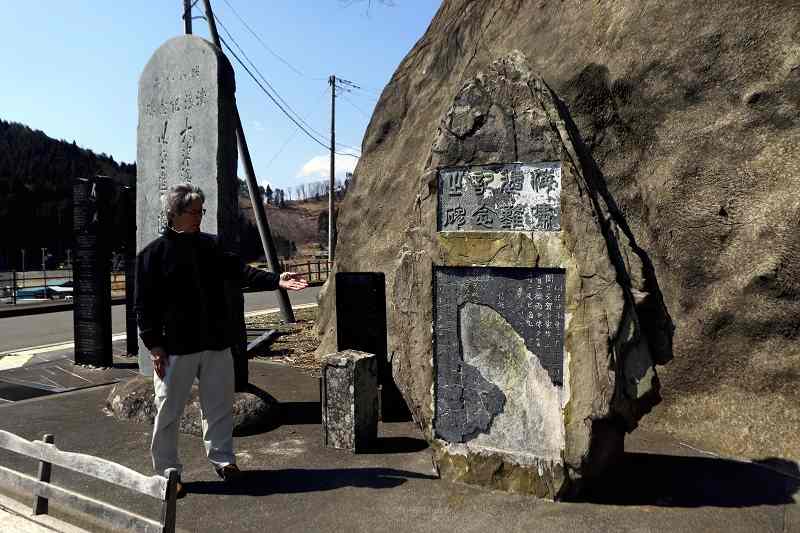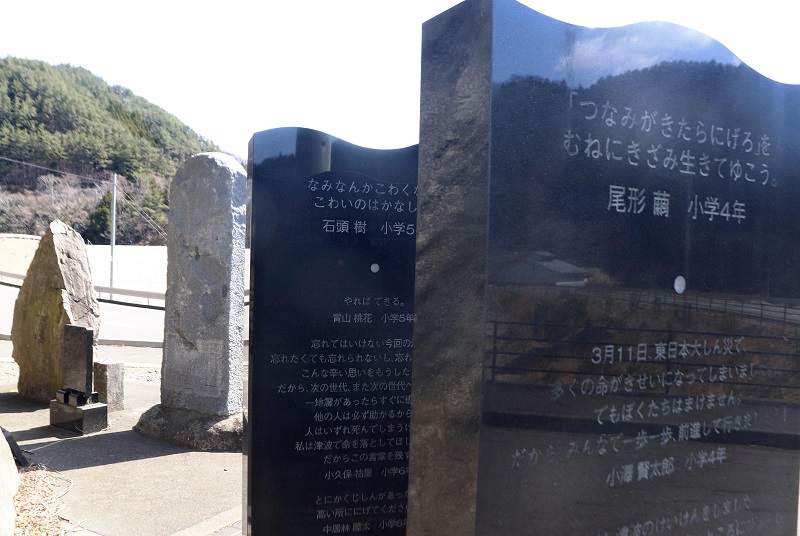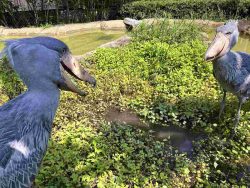
Naotaro Koike stands at the venue of three tsunami monuments in Kamaishi, Iwate Prefecture, on April 3.
17:39 JST, May 10, 2022
KAMAISHI, Iwate — Eleven years have passed since the Great East Japan Earthquake on March 11, 2011, but as monuments on the coast of Iwate Prefecture will attest, this was only the most recent major tsunami catastrophe to strike the region.
In the Hongo district of Kamaishi in the prefecture, three monuments stand side by side: one from the Meiji era (1868-1912), another from the Showa era (1926-1989) and the third from the Great East Japan Earthquake in the Heisei era (1989-2019).
I visited this place that tells the stories of each tsunami, amid the prefecture’s continuing efforts to keep attention on the recurring natural disaster. In late March, the prefectural government announced its renewed assessment of the possible height of the next potential tsunami.
The three monuments stand beside a prefectural road running along the coast. The oldest of the three is the Kaisho Sonan Kinen no Hi monument, which is 2.4 meters tall and 1.6 meters wide. It was erected by local residents in 1928 as a memorial to the 1896 Meiji Sanriku tsunami.
A board next to the monument explains what is inscribed, vividly describing the damage of that tsunami, which killed more than half the population of the Hongo district. The board contains a poignant sentence: “Noise like thunder suddenly came from the sea, and soon a high raging wave swept in, taking the lives of 800 people and destroying 300 houses.”
In 2008, the monument was moved to its current location, along with the Showa Hachinen Tsunami Kinenhi monument, which commemorates the 1933 Showa Sanriku tsunami.
Naotaro Koike, 75, president of the Hongo neighborhood association, recalled the 2011 tsunami, in which his house was swept away.
“I was surprised that a tsunami like the one described on the monument could happen again,” Koike said of the 2011 tsunami, which ripped off part of the inscription and washed it away.
Witnessing the horror of tsunami, which is conveyed by the monuments, Koike felt that monuments which pass on stories of tsunami to the next generation should be protected, and he worked hard to preserve the testimonials by pressing the city to restore the stone structure.
Prof. Shingo Hidaka of the National Museum of Ethnology in Osaka Prefecture, who specializes in preservation and restoration of cultural properties, was in charge of the restoration work, which lasted about a year from April 2020. The remaining inscriptions were reinforced, but the parts that had been washed away were not restored. This is because he thought not restoring it would convey the power of the tsunami.

The Yomiuri Shimbun
The most recent of the three installations, the Tsunami Kioku Ishi (Tsunami memory stone), was erected the year after the Great East Japan Earthquake. Messages from children who experienced the tsunami are inscribed in the monument, including “Run if a tsunami comes” and “Go to a high place as soon as an earthquake occurs.”
Koike said, “I hope that the memory of the tsunami, along with the Meiji and Showa monuments, will be passed down to future generations.
The Meiji, Showa, and Heisei eras: I couldn’t help but hope that the wishes of the people of each era on the monument will bear fruit and that as many lives as possible will be saved in the next disaster.
Related Tags
"Features" POPULAR ARTICLE
-

Sanrio to Open Museum in Yamanashi Pref. Dedicated to Founder, Exhibits Include Hello Kitty, Other Characters
-

Autumn Foliage Surrounds Visitors to Tokyo’s Showa Kinen Park
-

My Daughter No Longer Speaks to Me, But I Want to See Her and My Grandchild
-

Kumamoto: Public Bath Refurbished as Library Where You Can Chat, Take Photos
-

Frozen Vegetables: Demand Rises for Convenient, Tasty Domestic Produce
JN ACCESS RANKING
-

Keidanren Chairman Yoshinobu Tsutsui Visits Kashiwazaki-Kariwa Nuclear Power Plant; Inspects New Emergency Safety System
-

Imports of Rare Earths from China Facing Delays, May Be Caused by Deterioration of Japan-China Relations
-

University of Tokyo Professor Discusses Japanese Economic Security in Interview Ahead of Forum
-

Japan Pulls out of Vietnam Nuclear Project, Complicating Hanoi’s Power Plans
-

Govt Aims to Expand NISA Program Lineup, Abolish Age Restriction






















